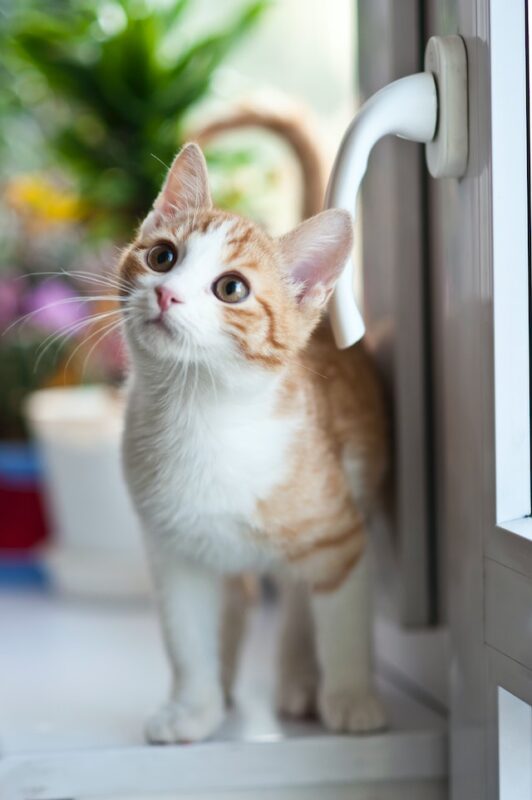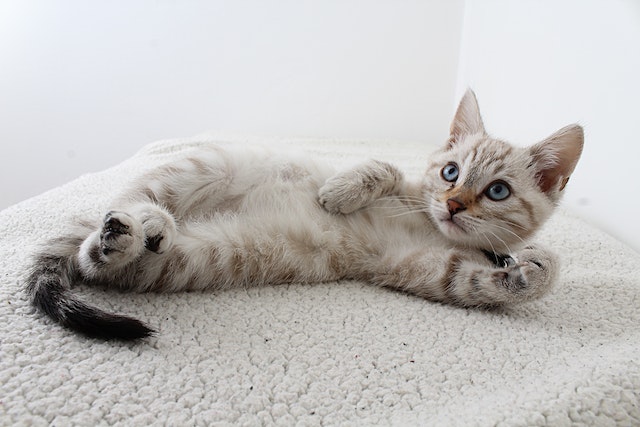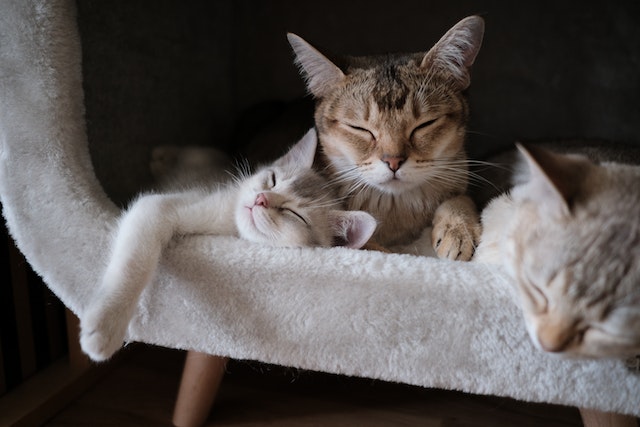Feline Leukemia: Causes, Signs & Treatment
Posted: 03/10/2023 | BY: Jenna Bruce | Categories: Cat , Pet care , Top Tips
Feline leukemia virus (FeLV) is a common infectious disease that affects roughly 2% to 3% of cats in the United States. Infection rates are typically higher in those cats who are battling another illness or are at high risk. Luckily, prevalence of the disease has decreased significantly in the past two decades since the development of accurate testing protocols and effective vaccines.

Feline Leukemia Transmission
The first thing to understand about feline leukemia is that it only affects cats and cannot be transmitted to people, dogs, or other animals. One of the most unique qualities of FeLV is its ease of transmission. This is important to recognize as young kittens, senior cats and those with compromised immune systems are at a much higher risk of contracting it than healthy adult cats. Males tend to contract the disease more than female cats, as do outdoor – or indoor/outdoor cats – who come into contact with more unfamiliar cats.
The most common means of transmission are:
Saliva and Nasal Secretions
Cats living in the same household will often participate in mutual grooming that involves the transfer of saliva. Often this saliva will come in contact with sensitive parts of the body such as the eyes, nose and mouth. Saliva from an infected cat may also be transferred to a non-infected cat through shared food and water bowls.
Milk
An infected mother cat can easily transfer FeLV to her nursing kittens through her milk. To make matters worse, these tiny kittens have underdeveloped immune systems that make it far harder for them to fight off the virus. Mothers are also able to pass the virus on to their kittens before they are born.
Urine and Feces
While not as common a means of transmission as some of the others on this list, it is still something to be aware of. Shared litter boxes allow non-infected cats to come into contact with infected urine and feces. Luckily, the virus can only last a few minutes outside of its host, so these particular transfers are far less likely to occur.
Bites
If your cat spends anytime outdoors, he or she may come into contact with aggressive cats in the neighborhood. Should an infected cat bite your cat, the virus can easily enter their bloodstream. Keeping your cat solely indoors helps to prevent this from happening.
Signs and Symptoms of Feline Leukemia

Feline leukemia affects a cat’s body in multiple ways. During the early stages of infection it is common for a cat to show few, if any, symptoms. As the virus replicates and takes hold over weeks, months and even years, your cat’s health will get progressively worse, and they may experience repeated cycles of illness.
The most common symptoms associated with FeLV are:
- Loss of appetite
- Progressive weight loss
- Poor coat condition
- Enlarged lymph nodes
- Persistent fever
- Pale gums and other mucus membranes
- Inflammation of the gums (gingivitis) and mouth (stomatitis)
- Infections of the skin, urinary bladder, and upper respiratory tract
- Persistent diarrhea
- Seizures, behavior changes, and other neurological disorders
- A variety of eye conditions
- Abortion of kittens or other reproductive failures
Risk Factors
As mentioned previously, kittens are particularly susceptible to feline leukemia because their immune systems aren’t fully developed yet. Senior cats, as well as those with chronic conditions that may compromise their immune system, are also at risk for contracting FeLV. Cats that live in multi-cat households are at higher risk as they share the same food and water bowls, as well as litter boxes. And finally, cats that are able to go outside are also at risk of contracting the virus from infected, aggressive cats.
The good news is that healthy adult cats have low risk of contracting FeLV because their resistance seems to increase with age.
Diagnosis
Whenever someone earns the trust of a stray cat and decides to adopt it, the first thing they need to do is bring that fur baby into the vet for some testing. There are two types of blood tests that are commonly used by vets to diagnose FeLV. Both tests detect a protein component of feline leukemia called FeLV P27.
The first test generally performed is called ELISA, which stands for an enzyme-linked immunosorbent assay. This is a screening tool your vet can perform right in the office. This test will detect any FeLV particles that are typically found in the bloodstream in the early and late stages of the infection.
Should the ELISA test come back positive, your vet will send a blood sample out to a diagnostic laboratory for an IFA test, or an immunofluorescent antibody assay test. This test will confirm an FeLV infection as well as determine the stage of infection.
Your veterinarian can help you determine which tests are appropriate for your cat and answer any questions you have about a possible diagnosis.
Treatment

Sadly, to date there has been no definitive cure developed for feline leukemia. There are some therapies that have shown promising results in their ability to decrease the amount of FeLV in the bloodstream of affected cats. However, these therapies often come with significant side effects and may also not be entirely effective.
Most veterinarians will treat specific problems that are secondary to the leukemia. For instance, prescribing antibiotics for recurring bacterial infections or performing blood transfusions for cases of severe anemia.
Before bringing any new cat into the home and introducing them to others, they will need to be tested. They will also need to be housed apart from your other cats until testing is complete.
There is a relatively effective vaccine for feline leukemia, though it will not protect 100% of cats vaccinated. Cat parents thinking about vaccinating their uninfected cats should consider their cat’s risk of exposure to FeLV infected cats and discuss pros and cons of vaccination with their veterinarian.
Since not every vaccinated cat will actually be protected by the vaccine, preventing exposure to the virus should be a priority.
How to Prevent Feline Leukemia

The following are the best ways to prevent your cat from contracting feline leukemia. The more of these guidelines you follow, the safer your cat will be from this serious and deadly disease:
Vaccines
Getting your cat vaccinated is really a first step in prevention. This is particularly true if your cat is an indoor/outdoor cat or if your home is a multi-cat household.
Test Regularly
Ideally your cat would be tested for FeLV on a regular basis if they are at risk for contraction. Speak with your vet about how often they recommend your cat be tested based on where you live and your cat’s age and lifestyle.
Limit Exposure
One of the best ways to reduce your cat’s chances of being exposed to FeLV is to keep them away from other strange cats. This means keeping your cats indoors or at the very least, keeping them on your property.
It’s a good idea to have your cat spayed or neutered as this helps prevent them from wandering or straying.
Test New Cats
Before bringing any new cat into your home, be sure to have them tested. Keep a new stray in a separate room away from your other cats until a negative test has been confirmed.
Managing Feline Leukemia

If your cat has been diagnosed with FeLV, watch her closely for any secondary health issues. This can include things such as bacterial infections and anemia. It is particularly important to quickly treat minor signs of illness in cats with the virus, as their immune system is compromised.
As an example, a healthy adult cat who sneezes a few times over the course of a couple of days may be fighting a feline cold or flu. Their body should be able to fight the infection easily. But a cat with feline leukemia may quickly develop pneumonia and require antibiotics and fluids.
Prognosis
No cat parent ever wants to get the news that their fur baby has a serious disease. While an FeLV diagnosis can feel devastating, it’s important to understand that cats with this virus can have a normal lifespan. The key is to prevent other secondary illnesses.
Diagnosed cats should be closely monitored for any changes in weight, appetite, activity level, elimination habits, appearance of the mouth and eyes, and general behavior. If anything at all seems off, take them in to the vet for a check-up. With FeLV, it’s better to be safe than sorry.
Final Thoughts
Feline leukemia is a serious illness that affects roughly 2%-3% of cats in this country. While there is a somewhat effective vaccine, your best bet to keep your fur baby safe is to follow our guidelines on preventing exposure. This is your greatest line of defense.
Keep Your Fur Baby Healthy with a Pet Insurance Policy
Another excellent line of defense is to make sure you enroll your cat in a pet insurance plan as early as possible. God forbid down the road they do contract FeLV or develop another serious illness, you may be looking at devastating vet bills. A pet insurance policy will help you provide the care your fur baby needs while also helping you save your personal finances.
Don’t take any chances. Get a free quote today.
References:
- Hartmann K, Block A, Ferk G, Beer B, Vollmar A, Lutz H. Treatment of feline leukemia virus (FeLV) infection. Vet Microbiol. 1999 Sep 1;69(1-2):111-3. doi: 10.1016/s0378-1135(99)00097-8. PMID: 10515279.
- Hoover EA, Mullins JI. Feline leukemia virus infection and diseases. J Am Vet Med Assoc. 1991 Nov 15;199(10):1287-97. PMID: 1666070.
- Cat Leukemia (Feline Leukemia Virus); Retrieved from: https://www.petmd.com/cat/conditions/infectious-parasitic/c_ct_feline_leukemia
- Feline Leukemia Virus; Retrieved from the Cornell College of veterinary medicine blog: https://www.vet.cornell.edu/departments-centers-and-institutes/cornell-feline-health-center/health-information/feline-health-topics/feline-leukemia-virus
- How to Treat Feline Leukemia; Retrieved from: https://www.thesprucepets.com/how-to-treat-feline-leukemia-5213536
Disclaimer
The information contained on this blog is intended for informational and educational purposes only and should not be construed as medical advice. It is not a substitute for professional veterinary care. Always consult with your veterinarian before making any changes to your pet's health care or treatment plan.
The authors of this blog are not veterinarians and do not claim to be experts in pet health. The information provided here is based on our own experiences and research, as well as information from reputable sources. However, we cannot guarantee the accuracy or completeness of this information.
We encourage you to do your own research and consult with your veterinarian before making any decisions about your pet's health.
Previous post
How Do Dogs Show Affection?Compare top pet insurance providers plans.
Enter your dog’s age in years and months to calculate their age equivalent to human years.
Calculate your dog’s ageEnter your cat’s age in years and months to calculate their age equivalent to human years.
Calculate your cat’s age